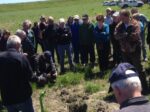Oasis amidst the dairy paddocks
Could dairy farms become sanctuaries for native flora and fauna? A new study is showing dairy and conservation sites can co-exist, and its findings are contributing to an ongoing project restoring natural biodiversity into a dairy farming environment. ‘Persistence of biodiversity in a dryland remnant within an intensified dairy farm landscape’, looks at Bankside Scientific Reserve, a small (2.6 ha) remnant in Canterbury surrounded by dairy paddocks, which still has valuable communities of native species, despite being impacted by nitrate and phosphate encroachment, and habitat fragmentation. It concludes “it does not appear to be an intractable management issue for the interface between agricultural systems and conservation sites within a dairy landscape mosaic”. One of the study’s authors, Professor of Ecology, Nick Dickinson, and other Lincoln scientists have been tasked by Ngāi Tahu Farming and Manawhenua from Tuahuriri Marae, to turn the little triangles of land which irrigators in paddocks cannot reach into an oasis for native plants and animals on Ngāi Tahu’s Eyrewell dairy farm. Professor Dickinson says the study shows there are “means and ways” to restore natural biodiversity into a dairy farming environment, and the Ngai Tāhu Farming project was an example, covering 150 hectares on 17 reserves, with a similar additional amount of native species being planted on paddock borders and under irrigators. These create conditions for more than 65 species of plants to regenerate, and also provide corridors for insects and birds between the reserves. The research hinges on finding the benefits to the farmer of doing this, to encourage more native planting, he says. www.lincoln.ac.nz








